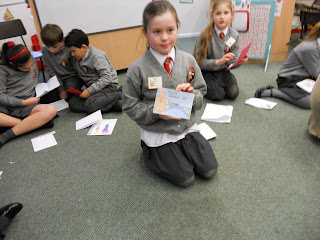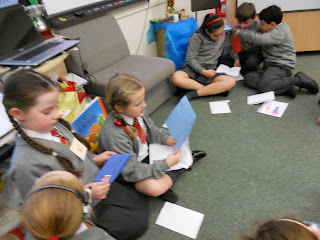
Welcome to our project "The Wallgate: Breaking brick walls // El Portal: Rompiendo muros", between the state primary school "All Saints" in Liverpool, UK, and "Rico Cejudo" in Sevilla, Spain. Bienvenidos a nuestro proyecto "The Wallgate: Breaking brick walls // El Portal: Rompiendo muros", entre el colegio público "All Saints" en Liverpool, UK, y el CEIP "Rico Cejudo" en Sevilla, España.
martes, 31 de enero de 2012
domingo, 29 de enero de 2012
How English children learn to read










In Y1 (5-6 years old), Y2 (6-7 years old) and Y3 (7-8 years old) teachers teach phonic every day for twenty minutes and also children that need more help have personalised learning support (PLS).
Children learn different sounds in phases.
Phase 1 Nursery involves a lot of listening games to practice listening skills.
They start phase 2 when they are about four (Reception) and learn single sounds for example: s,a,t,p,i,n...and they start to put them together to make words.
In the fase 3 the sounds are more complicated for example: ow,ee,ai... and then in phases 4 and 5 they learn alternative spellings of the same sound for example for the sound ai there are three other ways of writing it: play, train,same.....
At the end of Y1 the children should be secure in phase 5 or at least starting to recognise alternative spellings.
Phase 6 introduces and teaches the past tense. Children learn how to add suffixes for example -ed: worked, played, walked...They also learn spelling systems for longer words.
Children start to learn about phase 6 in Y2 and Y3.
Another way to learn to read is giving the children a selection of different books to read. They are encouraged to read every day at home. Teachers read at least twice a week with each child either individually or in a group which is called ´guided reading.´Teachers keep a note of their progress in a reading record. Also children take home a readindg card wich tells the parents how to help the children.
Teachers use different resources and different websites on e of them is phonicsplay.com
Los niños en los cursos Y1( 5-6 años), Y2 (6-7 años) y en Y3 (7-8 años) los profesores enseñan fonética todos los días durante 20 minutos. Además los niños que necesitan ayuda tienen un programa personalizado.
Los niños aprenden diferentes sonidos en fases.
Fase 1 en Nursery ( 3años) apreden destrezas y juegos.
Ellos empiezan fase 2, cuando ellos tienen 4 años (Reception) aprendiendo sonidos aislados como por ejemplo s, a, t, p,i n...y empezando a ponerlos juntos para hacer palabras.
En la fase 3, los sonidos son más complicados por ejemplo ow,ee, ai.... En las fases 4 y 5 aprenden diferentes maneras de leer los mismos sonidos, por ejemplo para el sonido ai hay tres maneras de escribirlos: play, train, same...
Al final de Y1 los niños deberían estar en la fase 5.
En la fase 6 se introduce y se enseña el pasado de los verbos y cómo añadir sufijos como por ejemplo -ed: worked, played, walked...Además aprenden reglas para formar palabras más largas.
En Y2 y en Y3 los niños deben haber alcanzado la fase 6.
Otra manera de enseñar a los niños a leer, es dándole una selección de libros, y animándolos a leer diariamente en casa. Los profesores leen al menos dos veces por semana con cada niño o en pequeños grupos con lecturas guiadas. Hacen sus anotaciones, las registran y la entregan al profesor que en el siguiente curso, estará al cargo de ese niño.
Los niños diariamente, junto con su libro de lectura, llevan un cuadernillo donde además de orientar alos padres cómo ayudar a sus hijos con la lectura, deben anotar observaciones sobre las páginas que han leido con sus hijos en casa.
Los profesores usan diferentes recursos y websites, una de ellas es phonicsplay.com
martes, 17 de enero de 2012
Christmas cards
Suscribirse a:
Entradas (Atom)


